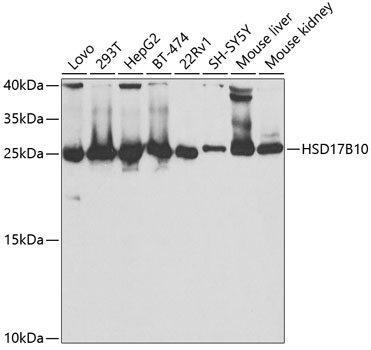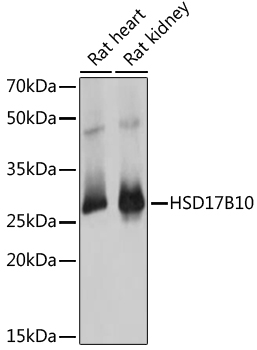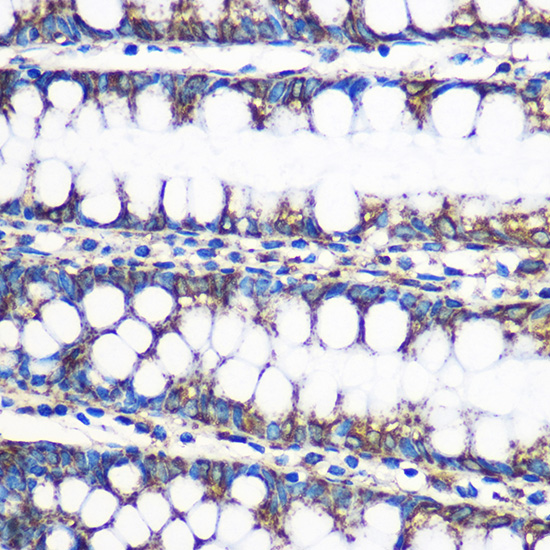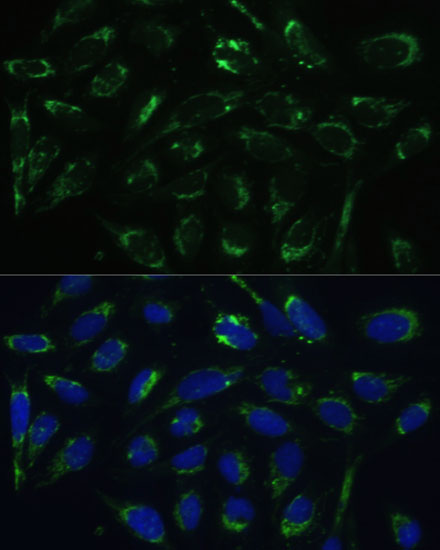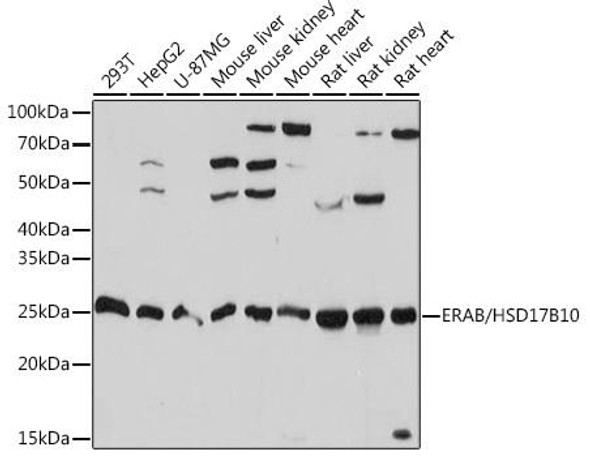Anti-HSD17B10 Antibody (CAB5448)
- SKU:
- CAB5448
- Product type:
- Antibody
- Reactivity:
- Human
- Mouse
- Rat
- Host Species:
- Rabbit
- Isotype:
- IgG
- Antibody Type:
- Polyclonal Antibody
- Research Area:
- Epigenetics and Nuclear Signaling
Description
| Antibody Name: | Anti-HSD17B10 Antibody |
| Antibody SKU: | CAB5448 |
| Antibody Size: | 20uL, 50uL, 100uL |
| Application: | WB IHC IF |
| Reactivity: | Human, Mouse, Rat |
| Host Species: | Rabbit |
| Immunogen: | Recombinant fusion protein containing a sequence corresponding to amino acids 1-261 of human HSD17B10 (NP_004484.1). |
| Application: | WB IHC IF |
| Recommended Dilution: | WB 1:500 - 1:2000 IHC 1:50 - 1:100 IF 1:50 - 1:100 |
| Reactivity: | Human, Mouse, Rat |
| Positive Samples: | Lovo, 293T, HepG2, BT-474, 22Rv1, SH-SY5Y, Mouse liver, Mouse kidney, Rat heart, Rat kidney |
| Immunogen: | Recombinant fusion protein containing a sequence corresponding to amino acids 1-261 of human HSD17B10 (NP_004484.1). |
| Purification Method: | Affinity purification |
| Storage Buffer: | Store at -20°C. Avoid freeze / thaw cycles. Buffer: PBS with 0.02% sodium azide, 50% glycerol, pH7.3. |
| Isotype: | IgG |
| Sequence: | MAAA CRSV KGLV AVIT GGAS GLGL ATAE RLVG QGAS AVLL DLPN SGGE AQAK KLGN NCVF APAD VTSE KDVQ TALA LAKG KFGR VDVA VNCA GIAV ASKT YNLK KGQT HTLE DFQR VLDV NLMG TFNV IRLV AGEM GQNE PDQG GQRG VIIN TASV AAFE GQVG QAAY SASK GGIV GMTL PIAR DLAP IGIR VMTI APGL FGTP LLTS LPEK VCNF LASQ VPFP SRLG DPAE YAHL VQAI IENP FLNG EVIR LDGA IRMQ P |
| Gene ID: | 3028 |
| Uniprot: | Q99714 |
| Cellular Location: | Mitochondrion |
| Calculated MW: | 25kDa/26kDa |
| Observed MW: | 26kDa |
| Synonyms: | HSD17B10, 17b-HSD10, ABAD, CAMR, DUPXp11.22, ERAB, HADH2, HCD2, MHBD, MRPP2, MRX17, MRX31, MRXS10, SCHAD, SDR5C1, HSD10MD |
| Background: | This gene encodes 3-hydroxyacyl-CoA dehydrogenase type II, a member of the short-chain dehydrogenase/reductase superfamily. The gene product is a mitochondrial protein that catalyzes the oxidation of a wide variety of fatty acids and steroids, and is a subunit of mitochondrial ribonuclease P, which is involved in tRNA maturation. The protein has been implicated in the development of Alzheimer disease, and mutations in the gene are the cause of 17beta-hydroxysteroid dehydrogenase type 10 (HSD10) deficiency. Several alternatively spliced transcript variants have been identified, but the full-length nature of only two transcript variants has been determined. |
| UniProt Protein Function: | HADH2: Functions in mitochondrial tRNA maturation. Part of mitochondrial ribonuclease P, an enzyme composed of MRPP1/TRMT10C, MRPP2/HSD17B10 and MRPP3/KIAA0391, which cleaves tRNA molecules in their 5'-ends. By interacting with intracellular amyloid-beta, it may contribute to the neuronal dysfunction associated with Alzheimer disease (AD). Defects in HSD17B10 are the cause of 2-methyl-3- hydroxybutyryl-CoA dehydrogenase deficiency (MHBD deficiency). MHBD deficiency leads to neurological abnormalities, including psychomotor retardation, and, in virtually all patients, loss of mental and motor skills. Defects in HSD17B10 are the cause of mental retardation syndromic X-linked type 10 (MRXS10). MRXS10 is characterized by mild mental retardation, choreoathetosis and abnormal behavior. A chromosomal microduplication involving HSD17B10 and HUWE1 is the cause of mental retardation X-linked type 17 (MRX17); also known as mental retardation X-linked type 31 (MRX31). Mental retardation is characterized by significantly sub- average general intellectual functioning associated with impairments in adaptative behavior and manifested during the developmental period. In contrast to syndromic or specific X- linked mental retardation which also present with associated physical, neurological and/or psychiatric manifestations, intellectual deficiency is the only primary symptom of non- syndromic X-linked mental retardation. Belongs to the short-chain dehydrogenases/reductases (SDR) family. 2 isoforms of the human protein are produced by alternative splicing. |
| UniProt Protein Details: | Protein type:Mitochondrial; Oxidoreductase; EC 1.1.1.51; Amino Acid Metabolism - valine, leucine and isoleucine degradation; EC 1.1.1.35; EC 1.1.1.178 Chromosomal Location of Human Ortholog: Xp11.2 Cellular Component: mitochondrion; endoplasmic reticulum; mitochondrial matrix; mitochondrial inner membrane; cytoplasm; plasma membrane Molecular Function:3(or 17)beta-hydroxysteroid dehydrogenase activity; protein binding; 7-alpha-hydroxysteroid dehydrogenase activity; 3-hydroxy-2-methylbutyryl-CoA dehydrogenase activity; 3-hydroxyacyl-CoA dehydrogenase activity Biological Process: tRNA processing; lipid metabolic process; branched chain family amino acid catabolic process Disease: Mental Retardation, X-linked, Syndromic 10; 17-beta-hydroxysteroid Dehydrogenase X Deficiency |
| NCBI Summary: | This gene encodes 3-hydroxyacyl-CoA dehydrogenase type II, a member of the short-chain dehydrogenase/reductase superfamily. The gene product is a mitochondrial protein that catalyzes the oxidation of a wide variety of fatty acids and steroids, and is a subunit of mitochondrial ribonuclease P, which is involved in tRNA maturation. The protein has been implicated in the development of Alzheimer disease, and mutations in the gene are the cause of 17beta-hydroxysteroid dehydrogenase type 10 (HSD10) deficiency. Several alternatively spliced transcript variants have been identified, but the full-length nature of only two transcript variants has been determined. [provided by RefSeq, Aug 2014] |
| UniProt Code: | Q99714 |
| NCBI GenInfo Identifier: | 2492759 |
| NCBI Gene ID: | 3028 |
| NCBI Accession: | Q99714.3 |
| UniProt Secondary Accession: | Q99714,Q5H927, Q6IBS9, Q8TCV9, Q96HD5, |
| UniProt Related Accession: | Q99714 |
| Molecular Weight: | 261 |
| NCBI Full Name: | 3-hydroxyacyl-CoA dehydrogenase type-2 |
| NCBI Synonym Full Names: | hydroxysteroid (17-beta) dehydrogenase 10 |
| NCBI Official Symbol: | HSD17B10 |
| NCBI Official Synonym Symbols: | ABAD; CAMR; ERAB; HCD2; MHBD; HADH2; MRPP2; MRX17; MRX31; SCHAD; MRXS10; SDR5C1; 17b-HSD10; DUPXp11.22 |
| NCBI Protein Information: | 3-hydroxyacyl-CoA dehydrogenase type-2; mitochondrial RNase P subunit 2; AB-binding alcohol dehydrogenase; mitochondrial ribonuclease P protein 2; 3-hydroxy-2-methylbutyryl-CoA dehydrogenase; short chain type dehydrogenase/reductase XH98G2; amyloid-beta peptide binding alcohol dehydrogenase; short chain L-3-hydroxyacyl-CoA dehydrogenase type 2; short chain dehydrogenase/reductase family 5C, member 1; endoplasmic reticulum-associated amyloid beta-peptide-binding protein |
| UniProt Protein Name: | 3-hydroxyacyl-CoA dehydrogenase type-2 |
| UniProt Synonym Protein Names: | 17-beta-hydroxysteroid dehydrogenase 10 (EC:1.1.1.51); 17-beta-HSD 10; 3-hydroxy-2-methylbutyryl-CoA dehydrogenase (EC:1.1.1.178); 3-hydroxyacyl-CoA dehydrogenase type II; Endoplasmic reticulum-associated amyloid beta-peptide-binding protein; Mitochondrial ribonuclease P protein 2; Mitochondrial RNase P protein 2; Short-chain type dehydrogenase/reductase XH98G2; Type II HADH |
| Protein Family: | 3-hydroxyacyl-CoA dehydrogenase |
| UniProt Gene Name: | HSD17B10 |
| UniProt Entry Name: | HCD2_HUMAN |


